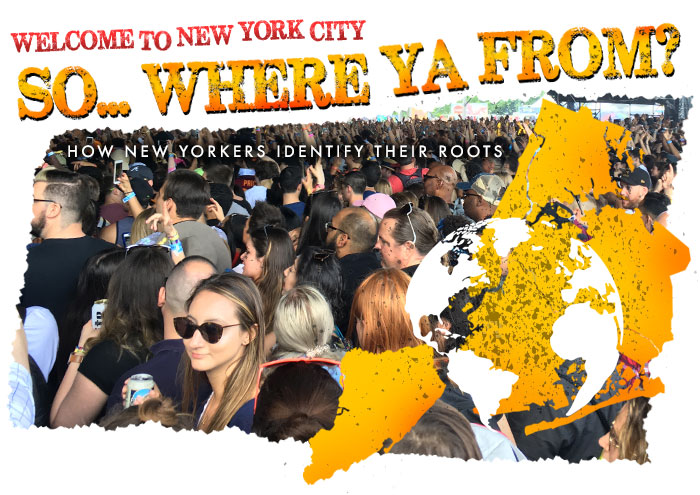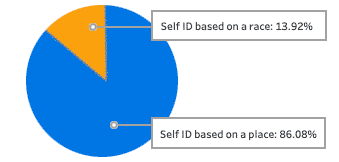
New York is the “crossroads of the world,” but among today’s residents, where did everyone come from? Or rather, how do they identify their roots when asked about their “ancestry,” either as newly arrived immigrants, first gen natives, or Gotham’s Old Guard of past generations? And, whether from far-off lands or just over the bridge-and-tunnel borders, where did they settle down amid the city’s constant change?
Looking at the most recent data to answer these questions poses two challenges. First, when using U.S. Census data from IPUMS USA, the most recent collection available – a sample excerpt from the 5-county population of NYC, about 144,000 records – was taken as NYC residents fled the city amid the COVID-19 pandemic, coupled with unprecedented procedural interference from Trump administration officials.
 Second, there is the “Race Versus Place” issue. The census data about ancestry was voluntary, with only a portion of those surveyed responding with answers. Even worse from a data collection standpoint, some responses about point of ancestry were vague (“Asian” or “Slavic”), while others were based on racial self-identifications (“African-American” and “Afro-American,” separate from responses as “American,” “North American,” or even various lineages back to African countries). And what about Black Hispanics who were only recorded in one category? Or people of mixed heritage? For the sake of completeness, ethnic-based “Lineage” is included on par with “Continents” in the graphs below. The responses are not scientific; they reflect how those surveyed expressed their desire to be seen as themselves…
Second, there is the “Race Versus Place” issue. The census data about ancestry was voluntary, with only a portion of those surveyed responding with answers. Even worse from a data collection standpoint, some responses about point of ancestry were vague (“Asian” or “Slavic”), while others were based on racial self-identifications (“African-American” and “Afro-American,” separate from responses as “American,” “North American,” or even various lineages back to African countries). And what about Black Hispanics who were only recorded in one category? Or people of mixed heritage? For the sake of completeness, ethnic-based “Lineage” is included on par with “Continents” in the graphs below. The responses are not scientific; they reflect how those surveyed expressed their desire to be seen as themselves…
^ View the above graphic on Tableau Public
^ View and expand the above graphic on Tableau Public | NOTE: The United Kingdom does not appear counted on the above map since England, Scotland, and Wales were tracked as separate ancestral identities in the source data. For U.K. metrics, see the Western Europe tallies below.
^ View and expand the above graphic on Tableau Public
Diversity By Borough
Finally, the following treemaps show the relative populations claimed by local New Yorkers in the IPUMS USA 2021 sample of 143,859 records.


^ View and expand the above graphic on Tableau Public


^ View and expand the above graphic on Tableau Public


^ View and expand the above graphic on Tableau Public


^ View and expand the above graphic on Tableau Public

^ View and expand the above graphic on Tableau Public
Who Cares Where Ya From? Does It Matter?
The impact of peoples’ heritage on New York City can be a blessing and a curse. Of the original IMPUS USA data pull, nearly 30% – or 42,098 – lacked any reported ancestry information. Ethnic identities, and especially racial ones, are social constructs with histories of fluid definition at best. Some may see “Where ya from?” in the same offensive light as asking BIPOC people, “What are you?”
But yeah, it matters.
On the bright side, New York City’s cultural diversity brings together a vast array of foods, fashions, and ideas. The iconic food truck industry alone and glutton magnets like Smorgasburg should be reason enough to celebrate the broad palate found across the five boroughs.
On the dark side, cultural and racial identities have an obvious history as excuses for inequalities, disparities, intolerance, and violence. For example, at the height of the New York Police Department’s “stop-and-frisk” policy for cases logged by police in 2011, a Hispanic man was four times as likely to be subjected to a stop as a white man, while a Black man was 10 times more likely to be stopped. According to quarterly analysis of NYPD records by the New York Civil Liberties Union, of the more than 685,700 “stop-and-frisk” encounters logged by police that year, 12% led to some form of criminal charges (possession of marijuana, prior outstanding warrants, or possession of a weapon). The remaining 88% of those stopped were completely innocent of any wrongdoing, but records of such stops could be used as “predictive guilt” in future legal matters.
But on the bright side… did I mention Smorgasburg?



Recent Comments